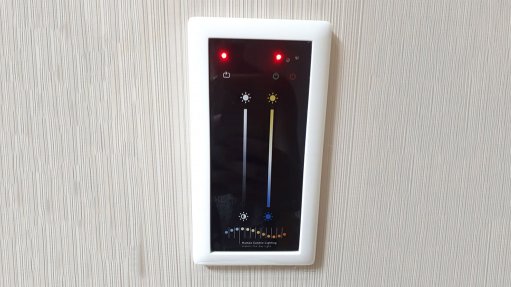
EFFICIENT LIGHTING Lighting for circadian systems requires different metrics from those used for conventional architectural lighting
Electrical solutions and lighting specialists Magnet Group, in partnership with electronic multinational company Philips, completed a pilot project for the design and installation of an energy efficient lighting system at property investment company Growthpoint Properties’ head offices, in Johannesburg, to enhance productivity.
The Magnet team has designed and installed a human-centric – replicating the daylight rhythms of humans – lighting system, with dynamic light levels and tones that change throughout the day, in all ground floor meeting rooms at Growthpoint’s offices, says Magnet Energy Gauteng divisional head Dean Lotter.
“Fine-tuned soft warm lighting helps people relax, while cooler bright white light assists occupants in remaining focused and feel energised throughout the day, stabilising the sleep-wake cycle and preventing unnatural delays in sleep onset in the evening.”
At the start of a work day, illuminance levels are increased to 500 lx to increase alertness and improve performance. Illuminance levels are increased slightly later in the day to enhance visual performance, stimulate mood and strengthen the body clock. Light levels and colour temperatures are reduced later in the day to prepare people to switch from the work to home environment, adds Lotter.
He says the advanced technology has a number of health benefits and occupants of the building will feel more alert, be more productive and benefit from working in an environment that has more ‘natural lighting’.
Compared with traditional fluorescent technologies, human-centric systems are about 50% more energy efficient, he adds.
Installation and Technology
Lotter says the design and manufacturing of the system took four months and, owing to the intricate wiring systems of the lights, Growthpoint staff had to undergo special training for four days before the installation of the lights in eight meeting rooms.
Lighting for circadian systems requires different metrics from those used for conventional architectural lighting. In specifying lighting for circadian rhythm, the team needed to evaluate the required light levels and spectral composition of the light levels of the meeting rooms, as well as spectral composition in general, and the timing and duration of lighting exposure, Lotter explains.
He adds that consideration was also given to prior light levels, uniformity, glare and kelvin temperatures that occupants of the building have become accustomed to.
He says the systems consists of kits for dynamic lighting functionality for biorhythm support and natural daylight, kits with a scene-setting functionality and sensors for presence detection and daylight dependent regulation.
“The touch panels and push button units allow for personal control of lighting according to work needs.” The lighting system can be installed in schools and hotels and in healthcare facilities to provide more effective healing environment using the natural power of light.
Lotter points out that the systems have automated preset curves, which control the intensity and colour temperature throughout the day.
“This environment-friendly project – our first local installation of circadian rhythm lighting – showcases Growthpoint’s commitment to innovative and green buildings. Visitors and staff are impressed with the ambience of this light-emitting-diode lighting system, which simulates natural daylight and provides excellent visibility for office work functionality,” Lotter concludes.